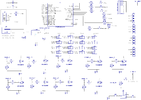Let's try to clear up some points:
● What you are trying to do IS NOT POV (Persistence Of Vision). POV is creating an image with moving LEDs that depends on the eyes' relatively slow response time to see a continous image. You may have seen the effect where a message is created from a strip of LEDs on a rotating bicycle where.
● What you ARE TRYING TO DO is multiplex LEDs so many appear to be on at the same time when in fact alternate groups are on from brief periods, making them all appear to be on at once. A multi-digit 7-segment LED display is an example of this. Eight digits may appear to be illuminated, but in fact, only one digit is illuminated at a time. This arrangement is typically done to reduce wiring and circuit complexity. A directly-controlled, always on 8 digit 7-segement LED requires 72 connections. A multiplexed 8 digit display requires 8 segment connections + 8 digit connections = 16 connections. Quite a savings!
These two concepts are similar, but not the same, so let's keep the terminology straight.
The question is what is MrDEB trying to do. A recent comment was "I want it to look like a bunch of LEDs are on at the same time" but the LEDs have also been described as "sprinkles on a birthday cake". Since this thread is called "Christmas Light Controller" and twinkles and sparkles have been discussed in MrDEB's numerous Christmas light projects, perhaps I have confused "sprinkles" and "sparkles" as the goal.
If the plan is to have "a mess of" static "sprinkles",, multiplexing is certainly the hard way to get there....a bunch of LEDs+series-resistors could easily be driven by a single mosfet, or several mosfets if separate colors is desired. Multiplexing the LEDs in this case leads to additional complexity and reduced brightness.*
Since the letters are animated, I assumed that the sprinkles would be too. Individual LEDs flashing on and off, and that appears to be the goal of MrDEB's code.
Some clarity of what's desired would be beneficial to everyone's sanity.
* Yes, when multiplexing with the LEDs only on for a brief period and off for an extended period, the LEDs may be pulsed at higher currents. However, during program development, this will lead to problems. Maybe an LED can be pulsed at 100mA, but can handle only 20mA continuously. If the software hangs leaving LEDs on at 100mA, the magic smoke will be released.
Pardon the long-winded post, but some clarity now will prevent murderous thoughts later.


